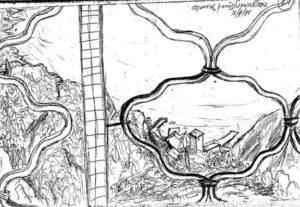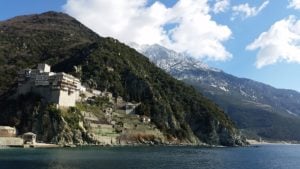Idyllic Paths on the Holy Mountain Sketes, hermitages and monasteries on the west coast of Athos
25 July 2016
Monastery of Grigoriou
Spouts and water from the mountain, occasional springs here and there. Faucets and water at the entrance to the monasteries, cooling passers-by and visitors alike. Streams with refreshing, crystalline water, their sources in the ravines and, higher up, in the untrodden gorges or at the root of some oak tree seen only by God. Water that flows down to the sea, water that kisses Athos. Holy water in the forests of pine on the way to Saint Ann’s. A spiritual spring of holy water. Every corner has a spring, overshadowed by a broad-leafed plane tree or crisscrossed with ivy. Refreshing moments when you quench your thirst, bodily and spiritually. Under the dense foliage the weather takes a rest. The paths as far as Vatopaidi are dripping with dew. An abundance of water on the way to Saint Ann’s. Springs and little rivers towards the [former] Russian skete of the Prophet Elijah. They look just like the nooks frequented by Eros and the nymphs and the sites of their festivities in the thick woods. They’re like moments of well-intentioned poetry, with the serene outburst of real contact, a moment of truth and an impulse restrained by faith on the path towards the one and only redemption.

From the balcony of the Monastery of Simonos Petras, the boat-house
Nature reveals the heavenly goods in its possession. The water’s like the nectar of the gods and brings other messages from Helicon or Pieria. The springs on the Holy Mountain, are a sign of life. Where there’s a spring, there’s a rich monastery, high and proud. Where there are springs there are walled gardens, corners which are fertile and blossoming, life and prayer. Springs which are sweet, but sometimes bitter with salt water. Springs, the mere sight of which draws the thirsty to their riches. Springs which steal their power from the snows. Springs with bulrushes and blooming wild flowers, monastic footprints and fairy-tale haunts of birds on the wooded slopes, untrodden by women ever, where nightingales and rock thrushes warble. A unique community surrounded by deep blue waters which kiss the sheer precipices of the sacred mountain. They wash the almost vertical rocks and the peaks are mirrored in the Aegean. The pines and planes grow profusely and the forests extend richly. Water flows abundantly. Small coves among the rocks, small respites from the struggle and from anxiety. The sketes are retreats. Some like abandoned villages, others nestled on the mountain, with caves and stone balconies. Kavsokalyvia, famous for its icon-painting workshops. Karouli, the most imposing as you look at it from the boat. The dwellings of the hermits hang as if suspended in the air, magnificent and impressive. You wonder how people live there and what needs they have. Saint Ann’s and New Skete, many signs and buildings as well. Many years ago these were bustling communities, now only a few eagles nest there, aged, but so tough in their challenges and so strong in their patience and endurance. Now these places are mostly abandoned but have great serenity. Each nest is a humble church, each sign a prayer-stand, each rock has heard words of faith. This is a landscape that cleanses you, lifts your spirits, and mitigates every sin. What thought is still the same afterwards, and how long can the battle of yesteryear last?

Monastery of Dionisiou
The little boat lets us off at the landing-stage of the Monastery of Saint Paul. A monastery with imposing architecture and a very interesting library. On the western side of the Mountain, a succession of monasteries: Saint Paul’s, Dionysiou and Grigoriou, built right next to the waves. Huge, rich buildings, one next to the other, stand out among the lush vegetation on the slopes, thyme and broom. Thousands of bee-hives on our path. The honey from the Holy Mountain is justly famous. At a height of three hundred metres above sea-level rises the Monastery of Simonos Petras. The sight of the building leaves you breathless. Seven storeys are firmly embedded into a large rock. Vertical, with the wooden balconies suspended over the void. A few small, hanging terraces. Take a few steps and there below you, in the distance, is the sea and the boat-house. You can hear the breeze rustling the foliage of the plane trees and see Sithonia opposite. The manifold beaches of Athos etch into the sea and become peaceful as the sun goes down. The gloaming is filled with colour and you hear the wooden simantro marking the start of Vespers.






